In This Issue
By Amy Nelson
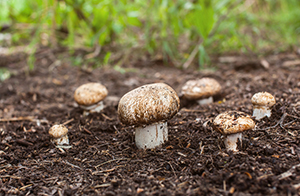
As people whose work involves an understanding of ecology, we are aware of the interconnectedness of things. When we walk through a forest, for example, we don’t just see dirt, leaf litter, trees, creeks, birds, insects, and other critters; we see biomass, carbon cycles, food webs, and watersheds. But to what extent does our holistic perspective include fungi? And how might a deeper understanding of this ubiquitous yet mysterious kingdom inform our work?
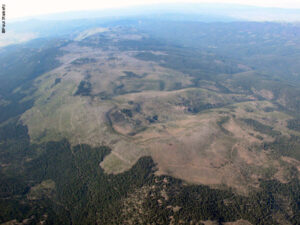
Though fungi exist just about everywhere, mere inches below the surface of the soil, they are largely invisible to us. Sure, we’re familiar with fungi’s fruiting body, the mushroom, but what do we really know about the organism itself, and the roles it plays in the ecosystems we work to protect and restore? When conditions are right and spores are released from the caps of mushrooms into the soil, threads of cells, called hyphae, grow from them. These tiny threads may only be a few microns in diameter, but a single teaspoon of rich soil can contain yards of them. As they continue to grow, hyphae branch and connect to form a network called mycelium, which can become mind-blowingly large and complex.
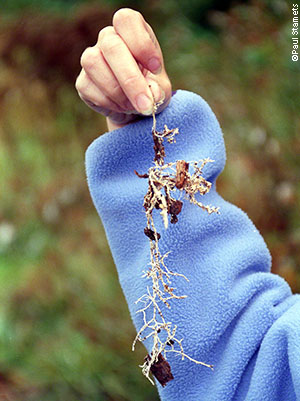
We humans are more closely related to fungi than any other kingdom of life. Animals and fungi diverged from a common ancestor, a single-celled organism that lived in the oceans. We both inhale oxygen and exhale CO2, and the fact that we share the same pathogens helps explain why some of our most important medicines, including penicillin, are derived from fungi. But there is something fungi do quite differently than us, and that difference is part of what makes it one of the driving forces of life on this planet. Fungi ‘eat’ by releasing enzymes outside of their bodies that break down nutrients into smaller elements that they can then absorb. Fungi’s unmatched ability to break down substances ranging from plant material to plastic makes them critical players in many ecosystems and potential power tools for environmental remediation and regeneration.

Mycologist and author Paul Stamets knows a lot about fungi’s potential to save the planet. In fact, one of his six books on fungi is entitled “Mycelium Running: How Mushrooms Can Help Save the World.” We were thrilled to chat with Paul and learn about the ways fungi can enhance our efforts to improve water quality, restore terrestrial ecosystems, preserve old growth forests, and possibly safeguard our food web.
We ecologists know that mychorrizal fungi, which have a symbiotic relationship with plants, help provide nutrients, minerals, and water to trees.
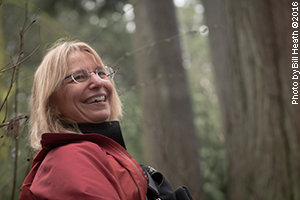
But as forest ecologist Suzanne Simard tells us, the role of these mycelial networks in forest ecosystems is much greater than that. Her research reveals a hidden “wood wide web” that facilitates communication and cooperation that benefits the entire ecosystem.
Jessica Hardesty Norris shines Leaf Litter’s spotlight on Radical Mycology, a grassroots organization dedicated to advancing the use of fungi to increase personal, societal, and ecological resilience.
 Fungi’s contributions to life on Earth are not limited to their important roles in ecosystems, medicine, and cuisine. They hold enormous potential to enhance sustainability by serving as a natural, renewable, biodegradable, non-toxic alternative to many products we use on a daily basis. In “You can do THAT with Fungi?” we highlight a few inspiring examples.
Fungi’s contributions to life on Earth are not limited to their important roles in ecosystems, medicine, and cuisine. They hold enormous potential to enhance sustainability by serving as a natural, renewable, biodegradable, non-toxic alternative to many products we use on a daily basis. In “You can do THAT with Fungi?” we highlight a few inspiring examples.
 If you have already begun compiling your 2017 reading list, you’ll want to check out this issue’s two book reviews. Ecological planner/designer Jennifer Dowdell reviews Judith Schwartz’s Water in Plain Sight: Hope for a Thirsty World and water resources engineer Bryan Arvai reviews The Hidden Half of Nature: The Microbial Roots of Life and Health by David R. Montgomery and Anne Bikle.
If you have already begun compiling your 2017 reading list, you’ll want to check out this issue’s two book reviews. Ecological planner/designer Jennifer Dowdell reviews Judith Schwartz’s Water in Plain Sight: Hope for a Thirsty World and water resources engineer Bryan Arvai reviews The Hidden Half of Nature: The Microbial Roots of Life and Health by David R. Montgomery and Anne Bikle.
 What better way to to celebrate the fungi kingdom than to share a mushroom-themed pot luck meal? After feasting on fungi-featuring foods in our Chesapeake/Delaware Bays and Southwest Basin & Range Bioregion offices, we selected our favorites. We’re happy to share photos and three winning recipes from our Fungi Feast.
What better way to to celebrate the fungi kingdom than to share a mushroom-themed pot luck meal? After feasting on fungi-featuring foods in our Chesapeake/Delaware Bays and Southwest Basin & Range Bioregion offices, we selected our favorites. We’re happy to share photos and three winning recipes from our Fungi Feast.
If this issue inspires you to learn more about fungi, explore our list of Resources and take a deeper dive.
As always, we share the latest news about Biohabitats Projects, Places, and People.
We always want to know what you think of Leaf Litter, and what topics you’d like to see us explore in future issues. If you have thoughts and ideas to share with us, Leaf Litter editor, Amy Nelson, would love to hear from you (anelson@biohabitats.com or @EcoCommunicator on Twitter)
Jessica Hardesty Norris shines Leaf Litter’s spotlight on Radical Mycology, a grassroots organization dedicated to advancing the use of fungi to increase personal, societal, and ecological resilience.
If this issue inspires you to learn more about fungi, explore our list of Resources and take a deeper dive.
As always, we share the latest news about Biohabitats Projects, Places, and People.
We always want to know what you think of Leaf Litter, and what topics you’d like to see us explore in future issues. If you have thoughts and ideas to share with us, Leaf Litter editor, Amy Nelson, would love to hear from you (anelson@biohabitats.com or @EcoCommunicator on Twitter)
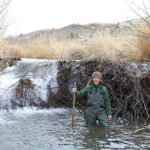
We humans are more closely related to fungi than any other kingdom of life. Animals and fungi diverged from a common ancestor, a single-celled organism that lived in the oceans. We both inhale oxygen and exhale CO2, and the fact that we share the same pathogens helps explain why some of our most important medicines, including penicillin, are derived from fungi. But there is something fungi do quite differently than us, and that difference is part of what makes it one of the driving forces of life on this planet. Fungi ‘eat’ by releasing enzymes outside of their bodies that break down nutrients into smaller elements that they can then absorb. Fungi’s unmatched ability to break down substances ranging from plant material to plastic makes them critical players in many ecosystems and potential power tools for environmental remediation and regeneration.
